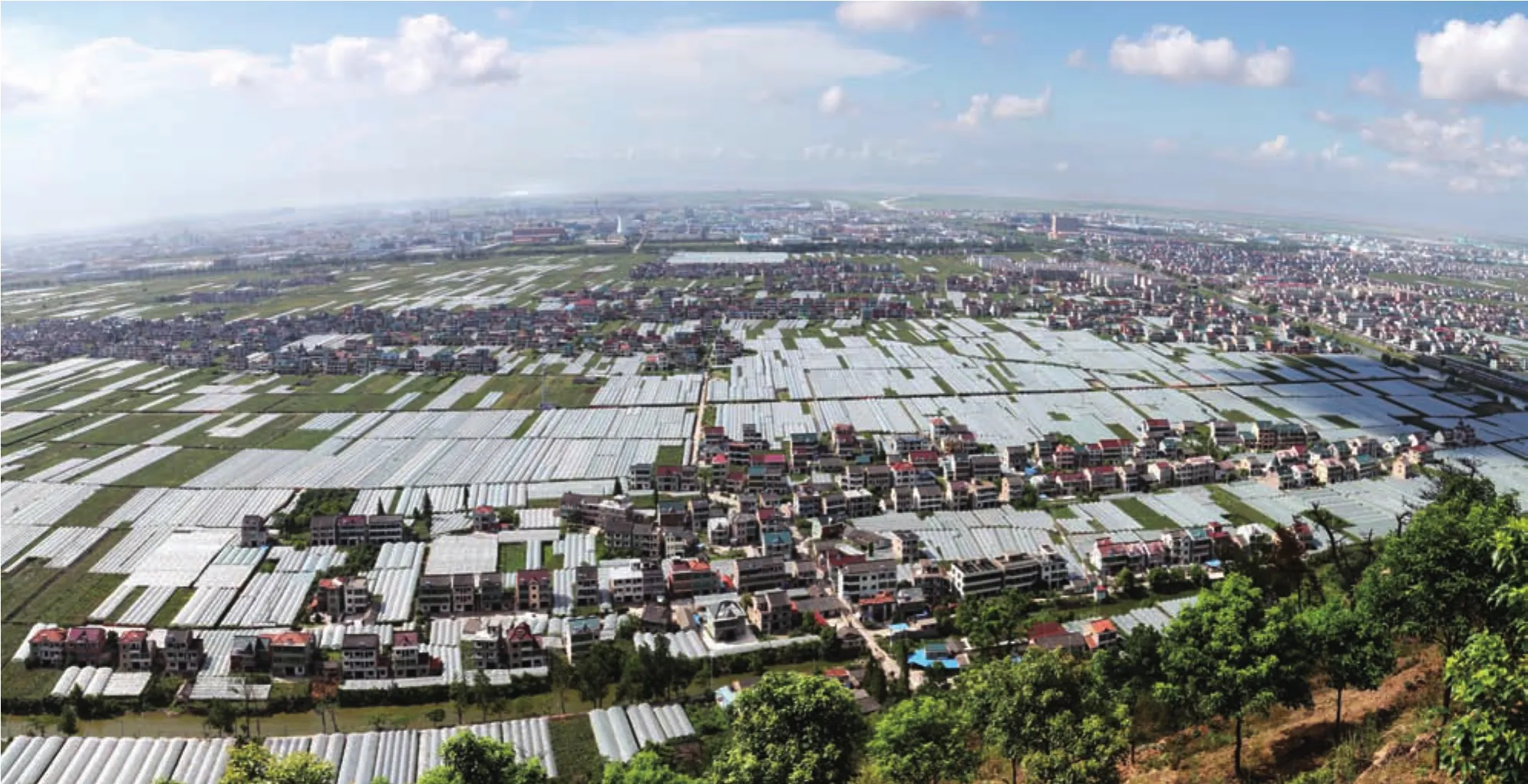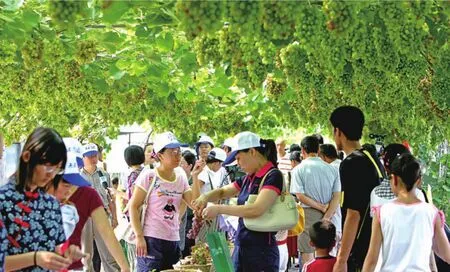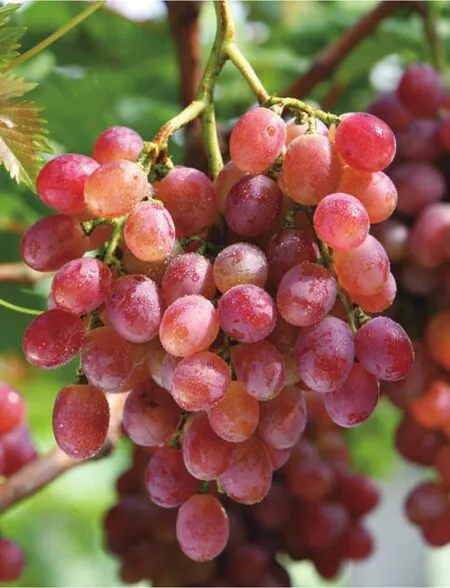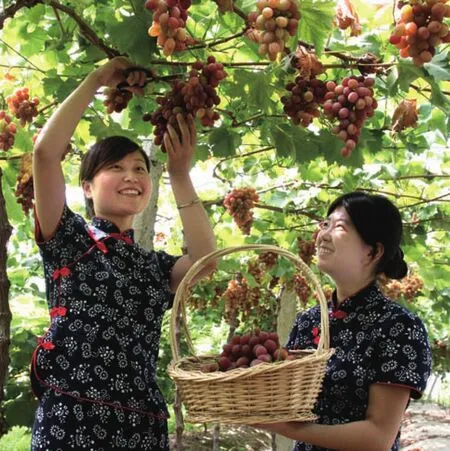“江南吐鲁番”的葡萄熟了
2022-08-26文/赵畅
文 /赵 畅

被誉为“江南吐鲁番”的绍兴市上虞区盖北镇万亩葡萄基地。刘育平/摄The Gaibei Grape Base covering 10,000 mu is known as “Turpan in Jiangnan”. Photo by Liu Yuping.
写下这个题目的时候,或许会有人质疑:“吐鲁番”可只属于新疆,是新疆葡萄特有的logo呀。然而,且慢!每年7至9月,当你来到绍兴市上虞区一个叫盖北的小镇,徜徉在1.2万亩葡萄园内的万顷碧波中,你定能领略作家笔下“那绿色团团簇簇,一扇扇绿窗似的悬着,缀着嫩绿色的窗帘,继而织成丝毯一般的绿墙,屏风似的挡了去路,人行其中,如同得了穿墙术,在草绿色的流苏中姿意穿行……”这诗一般的意韵,以致误以为自己就在新疆吐鲁番观光哩!
“君家小圃占春光,眼看龙须百尺长。移向楼边并寒井,明年垂实更阴凉。”但凡去过盖北,你就能发现如今的盖北,家家户户前前后后都被葡萄包围着、簇拥着,或者说,是互相亲昵着、交融着。难怪有人说,盖北分明就是一座种植着葡萄的大花园,而一个个大棚、一处处房前屋后则是一个个精致的小盆景,它们似乎谁都离不开谁,谁都衬托着谁,谁都提携着谁。
盖北被誉为“江南吐鲁番”, 既是出于西北农学院、全国著名葡萄专家贺普超先生之口,也是广大游客发乎内心口口相传的称赞。于是,随着声名远播,前去采摘观光的游客总是比肩继踵、川流不息。或许是考虑到暑天遮阴蔽日的需要,也或许是基于向游客直观推介的考量,盖北镇东大门所在的镇东村建起了一座生态园。据介绍,生态基地内有精品栽培面积170亩,建设有玻璃温室大棚3000平方米,基地全部采取大棚设施栽培,有高3.8米的标准钢管大棚设施栽培70亩。而最博人眼球的,则莫过于一条长290米、宽6米的游客休闲观光步道了。
不必说,沿着观光步道,姿态万千的葡萄基地尽收眼底,那一串串 “凝是银河落九天”般垂挂,且几乎要碰触到游人前额的葡萄,冲撞的可不只是你的眼帘,更有你的味蕾。其实,只要抬头看一看葡萄、读一读悬挂纸片上的品种简介,“巨峰、红富士、兴华一号、奥古斯特、美人指、无核白鸡心、夏黑、贵妃玫瑰、甬优一号、巨玫瑰……”等68个品种充满诗意的葡萄名,以及葡萄阵阵溢出的芬芳,早就让游客“意乱情迷”了。“别不好意思,想尝尝就自己摘呗!这观光步道本来就是为你们准备,供你们尝尝味道的……哈哈!”见游客们欲摘又止,陪同的基地管理服务人员便开始这样鼓励游客。
这观光步道,无疑是最好的广告词。是的,在这一串串凝红缀绿的葡萄面前,最好的广告词怕都会失去意义。而只要是生态园里有的葡萄品种,这里似乎都能找见。在微风的吹拂下,那一串串葡萄轻柔曼妙地成了列队的波斯舞娘,似乎正款款向游客走来。
“满筐圆实骊珠滑,入口甘香冰玉寒。”品种齐全的盖北葡萄,不光有着好听的名字,其色其形其味更有着独特的风韵。那葡萄白的像羊脂玉,绵密而敦厚;红的像红玛瑙,晶莹而澄澈;紫的像紫水晶,闪透而灵动;黑的像黑宝石,饱满而瓷实。每一粒葡萄,似乎都是吸纳天地精华而造就的尤物。尤其当你轻轻地剥去葡萄的皮子,那水灵灵、颤巍巍、嫩滑滑的果肉一口进入你的嘴里,你的牙齿、你的味蕾瞬间就无法安分,柔和筋道的果肉还未来得及被彻底捣碎、撕烂,何况你本来也想让其在齿间多停留一会儿而不忍早早落肚,但在美好的味觉诱惑下,思维逻辑已然混乱而不堪一击,于是,像饿狼似地一粒接一粒吞咽葡萄,便成了一种无可奈何地为美食“折腰”的必然窘境。
“我再带你们去参观一下我们的玫瑰葡萄,或许你们更有兴趣”,基地管理服务人员向游客推介旁边大棚里的玫瑰葡萄,这显然是不可调减的规定项目。“这是我们当地特有的一种葡萄,因为颜色像玫瑰色,味道也近似玫瑰味,故而俗称‘玫瑰葡萄’。”随着介绍来到大棚门口,阵阵玫瑰香味竟扑鼻而至、沁人心脾,有游客竟以为自己误入了玫瑰园。可更让人惊异的是,这里的葡萄大热天竟还被严严实实地套着白纸袋。“之所以套白纸袋,是因为这款玫瑰葡萄颇为娇贵,只要一沾水,它的皮就会绽裂,从而影响其形象、品质,进而影响销售及其效益。”经了陪同人员的一番解释,游客们始茅塞顿开、恍然大悟。原来,盖北位于上虞的北边,属于杭州湾南翼区域,背山面海,昼夜温差较大,夜间到早晨这段时间易于出现露水,所以葡农们才想出这一绝招。“本以为,这白纸袋一套,玫瑰葡萄会掉色丢味,可不知为何,这一招竟歪打正着,它反而愈加显得色艳香醇。”尽管有游客提出质疑,可当场取走一串葡萄的白纸袋后,游客们这才打消疑虑—但见其玫瑰色泽鲜亮诱人,其玫瑰香味也是纯正地道。于是,掌声便在人群中油然响起。其中,还免不了有游客当场掏袋购买。

游客纷纷来到葡萄园旅游观光。刘育平/摄Visitors swarm the vineyard. Photo by Liu Yuping.

葡萄新品种。刘育平/摄A new grape variety. Photo by Liu Yuping.
其实,早在700年以前,上虞就有葡萄栽培。据《嘉泰会稽志》记载:“会稽有浆水、玛瑙两种,虞邑有紫葡萄、水晶葡萄两种。”尤其是改革开放以来,随着不断引进葡萄新品种,不断拓展葡萄种植面积,当地逐渐赢得“中国葡萄之乡”“中国葡萄第一镇”的美誉,去年还通过了浙江省省级葡萄特色农业强镇创建。笔者曾经询问过长期在盖北镇工作的陈小明,他颇为自豪地告诉我:“沧海桑田不仅让盖北镇从昔日浊浪滔天的‘滩涂’变成了一马平川之地,而且中碱性土壤还孕育了生机盎然的迷人‘绿洲’,并造就了盖北葡萄酸甜爽口、清凉润喉的特色。”这几年,盖北镇还举办“野藤”葡萄文化旅游节,发展“葡萄采摘游”休闲旅游。去年,盖北镇游客总量突破50万人次,旅游总收入超过1.3亿元。
前不久的一天下午,我陪着几位记者前去盖北采访。夕阳澹澹、余晖漫漫之时,一位好客的葡农邀我们共进晚餐。拗不过葡农的盛情,我们留了下来。晚餐设在葡农的别墅里进行,而是被别具匠心地设在了屋门口的葡萄架下。觥筹交错之时,抬头而望,那缀满棚架的“野藤”葡萄,恰似夜空闪烁的星星,是那么的平易亲切,触手可及,不似星星那么地遥不可攀。尤其当我们从这位葡农口中获悉,近日上虞的“野藤”葡萄通过了农业农村部的农产品地理标志登记,盖北农民人均葡萄生产收入达到6000元以上,已然成为农户们的支柱性收入时,我们竟因惊喜而笑得格外的爽朗—那种快慰真不亚于吃下一串串盖北葡萄,也不逊于喝下一杯杯“野藤”葡萄酒。
Grapes Are Ripe in Jiangnan Turpan
By Zhao Chang
This title may lead to a little confusion here: Isn’t Turpan the place in Xinjiang, famous for delicious grapes? That, of course, is true. But if you visit a town called Gaibei in Shangyu, Shaoxing city from July to September, and wander through 12,000 mu(about 1650 acres) of lush green vineyards, you are very likely to take this place for the real Turpan.
If you have ever been to Gaibei, you will find that every household there has grapes around, or rather, the houses and grapes are intermingled with each other. No wonder some people say that Gaibei is a big grape garden, where greenhouses and dwellings are surrounded and visually complemented by small delicate bonsai-like grapes.
Gaibei is known as the “Turpan in”, said Mr.He Puchao, a famous grape expert from the Northwest A&F University, which is also recognized by tourists. As the reputation spreads, many tourists choose to go to Gaibei for grape-picking and sightseeing. Perhaps to add a cooling shade for hot summer, or to create a panorama for tourists, an ecological garden was built in the Zhendong village at the east gate of Gaibei. Statistics show that this garden has an ecological base for high-quality grape cultivation covering 170, and glass greenhouses of 3,000 square meters.Cultivation throughout the base is all done using greenhouse facilities, and 70of cultivation area are specially equipped with 3.8-meter-high greenhouses made of standard steel pipes. The most eye-catching item is a scenic trail, 290 meters in length and 6 meters in width.
Walking along the trail, you can see on both sides vast stretches of varied grapes coming in bunches, which are hanging like “the Milky Way falling from the sky” and could almost touch the foreheads of visitors. The grapes are a feast for not only your eyes, but also your taste buds. In fact, if you look up at the grapes and read their profiles written on the notes, you will find there are 68 varieties, including Giant Peak and Red Fuji. The poetic names of the grapes, as well as their fragrance, have made visitors intoxicated. “Don’t be shy, just go ahead and pick some if you want to try them!” Seeing some tourists hesitant to reach out and pick grapes, the service staff would encourage them in a friendly manner.
The trail is certainly the best advertisement. Any slogans,however well thought of, could never be more convincing than the bright-colored fruits themselves. You can find almost all the varieties along the trail in the ecological garden here.
The beauty of Gaibei grapes comes not only from their names alone. Their color, shape and taste are all charming in their own ways. The white ones are rich and thick like jade, the red ones,crystal and clear, resemble red agate, the purple ones are like amethyst, shining and dynamic, and the black ones like black jewels, plump and solid. Every grape seems to be specially and carefully made by nature. You can feel it when peeling off the fruit and put the juicy, wobbly, and slippery flesh into your mouth —your teeth and your taste buds will be instantly woken up, and you will not be able to resist the delicious temptation anymore but swallow them one after another like a hungry wolf.
“I’ll show you our rose grapes, maybe you’ll be more interested in them.” The service staff would then recommend strongly the rose grapes to the visitors. “This is a local variety.Because it has a rosy color and tastes like rose, it is commonly known as ‘rose grapes’.” Listening to the introduction, the visitors would walk closer to the entrance of the greenhouse, and smell whiffs of refreshing rose fragrance which could trick some people into believing they were in fact at a rose garden.

葡萄熟了。刘育平/摄Picking up grapes. Photo by Liu Yuping.
What is more surprising is that the grapes here in the heat of the day are still tightly wrapped with white paper bags. “Because the rose grapes are quite delicate. Any drop of water on their skin will cause the skin to crack thus affecting the appearance, quality and the sales,” explained the staff. It turns out that Gaibei, located in the north of Shangyu, to the south wing of Hangzhou Bay area,faces sea and has mountains at its back, with a big temperature difference between day and night. “At first we thought using the white paper bag would be harmful to the color and flavor, but for some reason it makes the grapes even more bright-colored and fragrant.”
As early as 700 years ago, there were grapes cultivated in Shangyu. According to a historical record, “there are two varieties— pulpy water grapes and agate grapes in Kuaiji, and two varieties— purple grapes and crystal grapes in Yuyi.” Especially since the Reform and Opening Up, with the introduction of new grape varieties and the expansion of the grape planting area, Gaibei has won the reputation of “the hometown of Chinese grapes” and “the first town of Chinese grapes”. Chen Xiaoming, a man who has long been working in Gaibei, proudly said, “During the course of time, not only has Gaibei turned from a mud flat into a flat land,but its alkaline soil has also given birth to a vibrant oasis. Thanks to all this, a unique grape variety has been cultivated, which has an outstanding sweet-and-sour, refreshing taste.” In the past few years,a grape-themed culture and tourism festival called “Wild Vine”was held in Gaibei, to develop a leisure tourism featuring grapepicking tours. In 2021, the total number of visitors to Gaibei exceeded 500,000 and the total tourism revenue reached over 130 million yuan ($19.15 million).
One afternoon not long ago, I accompanied some reporters to Gaibei. As the sun was setting, a hospitable farmer invited us to dinner. The dinner was not held inside the farmer’s house,but under the grape trellis in front of the house. When we were mingling, we looked up and saw the grapes on the trellis just like twinkling stars in the night sky, within our easy reach. The farmer told us that Shangyu’s “Wild Vine” grapes had recently passed the registration of geographical indications for agricultural products by the Ministry of Agriculture and Rural Affairs, and that the per capita grape-growing income of local farmers went over 6,000 yuan and had become a major source of farmers’ income. On hearing that, we were surprised and smiled heartily, as if we just had a bunch of Gaibei grapes or a glass of “Wild Vine” wine.
